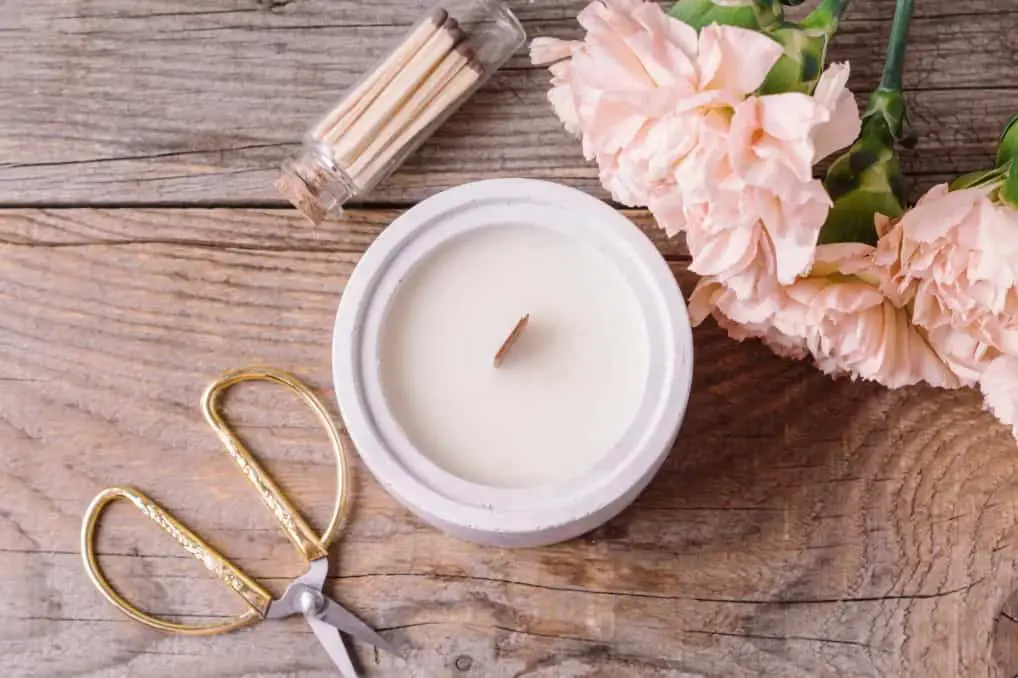We all know that candles provide ambiance, scent, and warmth. When you look for a deliciously scented candle, there’s an endless variety available, from clean and crisp linen to warm and spice pumpkin scents. After keen observation, you’ll notice that even identical-looking and scented candles contain different types of candle making waxes.

Wax is the ‘fuel’ of a candle that evaporates on candle melting and releases scent. Candle wax is definitely the most fundamental element for candle making. If you are new to candle making, you may have questions about what wax is best to use. Candle wax is made up of a variety of ingredients, and each has its own benefits. So it's important to know what you're getting into before you burn your candles. There are many types of candle wax, but the most popular are paraffin wax, soy wax, beeswax, coconut wax, and palm wax.
Most people thought they could make quality candles using any wax they found. But this is not true as there are several factors to consider while choosing the right wax. Candle makers typically choose between these types based on the scent they want their candles to produce as well as other properties. These include container size, fragrance throw, eco-friendliness, ease in candle making, and fragrance carrying ability.
In this blog post, we will discuss 5 of the most popular candle making waxes so that you can decide which one is suitable for your next project!
Let’s first have a look at the most common ingredients in candle making waxes:
Candle wax typically contains one or more of the following ingredients:
Beeswax: With a 145 degrees F melting temperature, beeswax produces a natural honey scent with great container adhesion and burn time.
Soy Wax: It is made from a 100 percent renewable resource; vegetable wax. At 120 degrees F, soy wax produces a good throw in most scents. But it is not a hard wax; it performs best when blended with other waxes. It is ideal for making container candles.
Paraffin: The most common yet versatile candle wax and the least expensive of all candle wax types. The melting temperature of mineral wax ranges between 90 degrees F and 130 degrees F. However, paraffin is a petroleum by-product that doesn't burn clean. Candle makers often blend this type of mineral wax with other ingredients to increase the burn time of a paraffin candle.
Candle wax often contains one or more of the following:
Stearic acid: Candle wax made from stearic acid provides a harder and smoother candle than most other types. Candle wax may contain up to 30% stearic acid for making a container candle for increasing burn time and decreasing soot production. Wax containing more than 30% of this ingredient may be too hard for container candles and should only be used in pillar candles or votive candles.
Candle dye and scent: Candle wax can include colors, fragrance oil, essential oil, or other additives to provide color or scent. Most candle manufacturers may use only natural ingredients for their candle wax, but others make a variety of specialty candle waxes that include synthetic dyes and scents.
Essential Oils: A new law exempts candle making companies from disclosing the ingredients in their fragrance oil or essential oil, so you can't be sure if they contain phthalates or other toxic chemicals.
Vitamin E: This antioxidant prevents the essential oils from going rancid, prolonging shelf life for up to two years.
Let's now dive into the top best candle making waxes.
No. 1 Candle making waxes: Beeswax
Top on our list of best candle making waxes is beeswax. Worker bees make beeswax in a 100 percent eco-friendly process. Worker bees make cells in their hives and store honey and newborn in these cells.
Beeswax consists of esters of fatty acid. Candle companies and homemade candle makers prefer beeswax over other types of candle waxes because they burn to release a natural honey scent and produce a lovely golden glow, just like sunlight.

Beeswax candles are eco-friendly as they do not release harmful chemicals. They burn clean, meaning they're smokeless and soot-free. Most importantly, they release negative ions to remove dust. These candles are perfect for allergic and athematic patients. Also, beeswax candles do not drip, so they are less messy than other candles.
Beeswax is quite expensive as it's hard to get. No bees are harmed during harvesting. Due to reductions in open fields and industrialization, bees are reducing at an alarming speed. Bees have to visit thousands of flowers to make a small volume of beeswax.
So, we can wrap the benefits of beeswax candles as;
- Beeswax burns clean and soot-free.
- The candle gives a natural honey aroma and golden glow.
- Beeswax produces negative ions that purify the air.
- It is eco-friendly and promotes pollination.
No. 2 Candle making waxes: Soy wax
Next up is the crowd's favorite soy wax. Soy wax or vegetable wax is obtained by harvesting, cleaning, cracking, and flaking soybeans. Soy flakes are then pressed to extract soy oil, which is then hydrogenated to make soy wax. It is, by far, the most popular candle making waxes.
Soy wax is eco-friendly candle wax. However, some people still have some concerns over its eco-friendliness. Soy candle wax is the by-product of a giant soybean industry, which might be growing and promoting the use of GMO soybeans.
Nonetheless, it is more environmentally friendly compared to traditional paraffin wax. Soy candle wax is biodegradable and burns clean, with little or no toxic soot and chemicals released. It is free of lead, sulfur, formaldehyde, and phthalates.
It has a very mild scent throw; that’s why they give the perfect atmosphere for aromatherapy sessions. It requires no additional additives to enhance fragrance carrying capacity. Additionally, soy wax is an excellent fragrance carrier. It has a cooler burning temperature, so soy candles burn longer. This quality makes soy wax candles cost-effective.
Candle brands often blend soy wax with other natural waxes, like beeswax or palm wax, to get the best of both waxes. However, everyone loves soy-paraffin blended wax.
Working with soy wax to make homemade candles is also very easy. Just buy soy wax or soy wax blend, be it in the form of sheets or flakes. Melt the soy wax flakes, add some essential oil, set the wick, pour it into the mold, and let it cool. Your soy candle is ready to use.
The pros and cons of soy wax
Just like beeswax, we can wrap the benefits of soy wax as follows:
- It is a vegetable-based, renewable, and biodegradable source of natural wax.
- Soy candle wax is slow-burning, meaning the candle will burn for longer hours.
- It is eco-friendly (if obtained from non-GMO soybeans).
Soy wax candles have some drawbacks too. These candles are temperature-dependent, meaning they can shrink and expand according to temperature. You have to keep these candles at a warmer temperature as these can shrink in the cold. Whereas, in humidity, they become fuzzy.
Soy wax candles have one more drawback: any fragrance can be mixed with them, but these are not good with all of them. For making soy wax candles at home, you have to check this by the hit and trial method.
No. 3 Candle making waxes: Coconut wax
Coconut wax is made from cold-pressed coconut meat or coconut oil. It is colorless and odorless wax. It is blended with other waxes to enhance its burn quality and scent throw.
Coconut wax is one of the most clean-burning, eco-friendly, and vegan-friendly waxes. Coconut wax candles burn the cleanest among all types of candle making waxes because they do not produce soot.
Since the wax is colorless, you can easily dye it and create various colored coconut wax candles. For this reason, it is blended with other waxes such as beeswax. Coconut wax burns slower than other waxes and lasts longer. Definitely, worth the money!
When blended with soy wax, it gives an amazing scent throw; that’s why coconut-soy candles are preferred for aromatherapy sessions. They release the perfect scent that helps to relax and rejuvenate the mind, body, and soul.
The key benefits of coconut wax are as follows:
- Coconut wax is the most clean-burning and biodegradable wax.
- It offers an amazing hot and cold scent throw.
- Coconut wax candles burn slow and last longer.
Until now, we discussed the benefits of coconut wax, but there are some drawbacks too. This is the most expensive wax type among all waxes, and it is very difficult to find as this is a relatively new wax type. But, this shouldn’t stop you from making eco-friendly candles and feeling good about planet earth.

No. 4 Candle making waxes: Palm wax
Next in the line of luxurious candle making waxes is palm wax. It is obtained from the hydrogenation of red-orange colored palm oil extracted from palm fruit. Palm wax is then bleached to make colorless candle wax. It holds on to the fragrance firmly and offers a fantastic scent throw.
Palm wax is an all-natural, renewable resource and an excellent alternative to regular candle making waxes. Palm wax is eco-friendly because it is plant-based, and paraffin wax is obtained from fossil by-products.
But it is not a 100 percent sustainable alternative to paraffin or other waxes. The palm oil industry fosters deforestation through slash-and-burn agriculture.
No. 5 Candle making waxes: Paraffin wax
Paraffin wax is by far the most popular yet cheapest of candle making waxes. It is obtained from petroleum by-products. It has been used in the candle making industry for the longest period of time.
Paraffin wax has the ability to carry loads of fragrances and colors. It offers the most excellent scent throw. This is why it is preferred and often blended with other natural waxes. Paraffin wax candles are very easy to make as it is cheap in cost and readily available.
Paraffin wax is not eco-friendly or a sustainable choice for making candles. First of all, paraffin is a petroleum by-product that burns to produce toxic fumes and smoke. This negatively affects indoor air quality as well as human health. Also, burning paraffin wax candles leaves black soot marks on the surrounding walls. Moreover, these candles drip and have a rapid burning rate.
All in all, paraffin wax is a bad choice for making candles and our planet earth.
What is the best candle making wax to use for homemade candles?
Your choice of candle wax should depend on the factors like the type of candle you want to make, the burning time of the wax, scent throw, and ease of use.
Candle wax type
You might want to use a hard wax if you wish to make freestanding pillar candles or tapers. Paraffin wax is the best in this regard. It can maintain its shape as it burns and melts. Most candle brands also use a soy-paraffin blend in making freestanding taper or pillar candles to satisfy their eco-consciousness.
Container candles, such as small votive and tea lights, work well with softer wax, such as beeswax, soy wax, or palm wax.
Burning time of candle wax
Among natural candle making waxes, beeswax and soy wax burn the longest. In comparison, coconut wax and palm wax offer a medium-to-long burning time. Paraffin wax, the notorious fossil by-product, has the shortest burning time.
The burn time is related to the melting temperature of the wax. The higher the melting temperature of the wax, the longer it burns. The melting temperature for beeswax is 149 degrees F, while that for soy wax is 130 degrees F. By contrast, the melting temperature for paraffin wax is only 99 degrees F.

Scent throw of candle wax
The scent throw is an important aspect of candle waxes in making scented candles. It is the ability of a candle to release the fragrance into the surrounding air. Inhaling the fragrance of essential oils when diffused from a burning scented candle relaxes our nerves and relieves stress. Thus, it gives you the benefits of aromatherapy in any comfy corner of your house.
Paraffin wax and soy wax are the best when it comes to holding fragrances and colors. Since paraffin is not eco-friendly, most high street candle brands like to use blended wax such as soy-paraffin or coconut-paraffin to boost their hot or cold scent throw.
Mix your favorite essential oils into the melted wax. Some waxes can hold more scents than others; the ideal fragrance load recommended by candle makers is 6 to 10 percent.
Ease of use with candle wax
If you are new to candle making, soy wax is the easiest to start with. It is easily available online and in-stores. Unlike paraffin wax that is available in hard blocks to cut, soy wax is easily available in the form of small chips or flakes.
Soy wax is ideal for making any candle, be it freestanding or container candles. However, if you want to make scented tealights candles, use paraffin wax instead. It offers a great scent throw for its small size.
What is a good alternative to traditional wax candles?
Traditional candles are usually made from paraffin wax. Paraffin is a by-product of petroleum. It is cheap and easily available, thus, used to make most of the candles. But burning paraffin candles leaves black soot marks inside the container and on the walls. It also produces smoke that releases particulate matter and carcinogenic compounds into the surrounding air. Particulate matter is a combination of tiny fluid beads and particles that can enter your lungs.
There's concern that long-term exposure to particulate matter can prompt heart and lung issues. In case you're utilizing candles appropriately in a very much ventilated space, they're probably not going to affect your wellbeing altogether.
Still, there are better alternatives to traditional candles available. Some renewable alternatives to candles are beeswax, soy wax, and palm wax with a cotton candle wick.
For those who desire a non-toxic, non-polluting indoor environment, soy wax, beeswax, and coconut wax candles provide peace of mind. When you visit any store to buy candles, make sure to check 100% soy wax, beeswax, or coconut wax labels. This is because companies like to create wax blends with paraffin wax to enhance the scent throw because it is easily available at a lower price.
Can you use essential oils in candles?
Yes, you can use essential oils in candle making waxes. Essential oils are extracted from plants and herbs at a high temperature, around 250 degrees F.
When it comes to high heat, some essential oils work better than others, depending on varying flashpoints. If any oil can handle more heat with more flashing points, it doesn't mean the oil won’t work perfectly in a candle at a low flashpoint. But it means you need to cool off the wax first. Use a thermometer to monitor the temperature. Add oil only when the wax has cooled to 185 degrees F, and stir gently. This is the best temperature for the wax and oil to combine. Add no more than 30 drops of essential oil to the wax melt. Soy wax, for example, can handle the fragrance load of 6-10 percent per ounce of wax. The excessive essential oil can cause dripping or candle sweating.
Wrapping up
So, today you learned that different types of candle waxes perform differently in candle making. If you’re looking for clean-burning candle wax, then soy wax can be your best friend. And, if you are dying to unwind in your dimly lit yet scented room, I’d suggest you invest some bucks beeswax for making homemade candles. The warm glow and a mild honey aroma are definitely worth every penny of your hard-earned money. But, if you are looking to boost the accent decorations, be sure to make scented tealight candles with paraffin wax. It will give you a stronger scent throw for a tealight or votive candle and won’t be burning for more than 4 hours. This way, you can enjoy the ambiance of a scented candle without feeling guilty about the planet.






